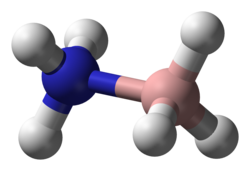Ammonia borane

| |

| |
| Names | |
|---|---|
| IUPAC name
Ammoniotrihydroborate
| |
| Other names | |
| Identifiers | |
3D model (
JSmol ) |
|
| ChemSpider | |
ECHA InfoCard
|
100.170.890 |
| EC Number |
|
PubChem CID
|
|
| UNII | |
CompTox Dashboard (EPA)
|
|
| |
| |
| Properties | |
| H3NBH3 | |
| Molar mass | 30.87 g·mol−1 |
| Appearance | Colorless crystals |
| Density | 0.78 g/cm3 |
| Melting point | 104 °C (219 °F; 377 K) |
| Structure | |
| I4mm, tetragonal | |
| Tetragonal at B and N | |
| Tetrahedral at B and N | |
| 5.2 D | |
| Hazards[4] | |
| GHS labelling: | |
 
| |
| Danger | |
| H228, H302, H315, H319, H332, H335 | |
| P210, P240, P241, P261, P264, P264+P265, P270, P271, P280, P301+P317, P302+P352, P304+P340, P305+P351+P338, P317, P319, P321, P330, P332+P317, P337+P317, P362+P364, P370+P378, P403+P233, P405, P501 | |
| Related compounds | |
Related compounds
|
|
Except where otherwise noted, data are given for materials in their standard state (at 25 °C [77 °F], 100 kPa).
| |
Ammonia borane (also systematically named ammoniotrihydroborate[citation needed]), also called borazane, is the chemical compound with the formula H3NBH3. The colourless or white solid is the simplest molecular boron-nitrogen-hydride compound. It has attracted attention as a source of hydrogen fuel, but is otherwise primarily of academic interest.
Synthesis
Reaction of diborane with ammonia mainly gives the diammoniate salt [H2B(NH3)2]+[BH4]− (diammoniodihydroboronium tetrahydroborate). Ammonia borane is the main product when an adduct of borane is employed in place of diborane:[5]
- BH3(THF) + NH3 → BH3NH3 + THF
It can also be synthesized from sodium borohydride.[6][7][8]
Properties and structure
The molecule adopts a structure similar to that of

The structure of the solid indicates a close association of the NH and the BH centers. The closest H−H distance is 1.990 Å, which can be compared with the H−H bonding distance of 0.74 Å. This interaction is called a dihydrogen bond.[10][11] The original crystallographic analysis of this compound reversed the assignments of B and N. The updated structure was arrived at with improved data using the technique of neutron diffraction that allowed the hydrogen atoms to be located with greater precision.
![Part of the crystal structure of ammonia borane[10]](http://upload.wikimedia.org/wikipedia/commons/thumb/9/93/Ammonia-borane-xtal-3D-balls.png/300px-Ammonia-borane-xtal-3D-balls.png)
| Molecule | Ammonia borane[12] | Aminoborane[13] | Iminoborane[14] |
|---|---|---|---|
| Formula | BNH6 | BNH4 | BNH2 |
| Class | amine-borane
|
aminoborane | iminoborane |
| Analogous hydrocarbon | ethane | ethylene | acetylene |
| Analogous hydrocarbon class | alkane | alkene | alkyne |
| Structure | 
| ||
| Ball-and-stick model | 
|

|
|
| Hybridisation of boron and nitrogen | sp3 | sp2 | sp |
| B-N bond length | 1.658 Å | 1.391 Å | 1.238 Å |
| Proportion of B-N single bond | 100% | 84% | 75% |
| Structure determination method | microwave spectroscopy | microwave spectroscopy | infrared spectroscopy |
Uses
Ammonia borane has been suggested as a storage medium for hydrogen, e.g. for when the gas is used to fuel motor vehicles. It can be made to release hydrogen on heating, being polymerized first to (NH2BH2)n, then to (NHBH)n,[15] which ultimately decomposes to boron nitride (BN) at temperatures above 1000 °C.[16] It is more hydrogen-dense than liquid hydrogen and also able to exist at normal temperatures and pressures.[17]
Ammonia borane finds some use in organic synthesis as an air-stable derivative of diborane.[18] It can be used as a reducing agent in transfer hydrogenation reactions, often in the presence of a transition metal catalyst.[19]
Analogous amine-boranes
Many analogues have been prepared from primary, secondary, and even
- Borane tert-butylamine((CH3)3C−NH2→BH3)
- Borane trimethylamine ((CH3)3N→BH3)
- Borane isopropylamine ((CH3)2CH−NH2→BH3)
The first amine adduct of borane was derived from
See also
- Tert-butylammonium borane(tBuNH2→BH3)
- Phosphine-borane (R3P→BH3)
- borane dimethylsulfide ((CH3)2S→BH3)
- borane–tetrahydrofuran (THF→BH3)
References
- ^ https://patents.google.com/patent/WO2015177483A1/en
- hdl:10297/10128.
- ^ https://www.sigmaaldrich.com/GB/en/search/borazane?focus=products&page=1&perpage=30&sort=relevance&term=borazane&type=product
- ^ https://pubchem.ncbi.nlm.nih.gov/compound/Ammonia-borane
- .
- .
- PMID 25274135.
- ^ a b
Staubitz, Anne; Robertson, Alasdair P. M.; Manners, Ian (2010). "Ammonia-Borane and Related Compounds as Dihydrogen Sources". Chemical Reviews. 110 (7): 4079–4124. PMID 20672860.
- ISSN 0004-9425.
- ^ .
- ISBN 978-0135615980.
- doi:10.1063/1.444528.
- .
- doi:10.1063/1.453462.
- ^ Gutowski, M.; Autrey, T. (2006). "Features: Hydrogen gets onboard". Chemistry World. 3 (3).
- PMID 21182274.
- PMID 17576485.
- ISBN 978-0471936237.
- .
